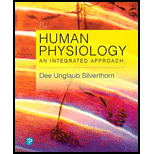
Human Physiology: An Integrated Approach (8th Edition)
8th Edition
ISBN: 9780134605197
Author: Dee Unglaub Silverthorn
Publisher: PEARSON
expand_more
expand_more
format_list_bulleted
Question
Chapter 6.4, Problem 17CC
Summary Introduction
Introduction: The activation of a receptor is followed by the cellular response, and it depends on the type of receptor isoform that is involved in the process of activation. The hormone epinephrine has α, and β2 adrenergic receptors and these two receptors are isoforms of each other.
Expert Solution & Answer
Want to see the full answer?
Check out a sample textbook solution
Students have asked these similar questions
Standard Concentration (caffeine) mg/L
Absorbance Reading
10
0.322
20
0.697
40
1.535
60
2.520
80
3.100
Please draw in the missing answer, thank you
Please fill in all blank questions, Thank you
Chapter 6 Solutions
Human Physiology: An Integrated Approach (8th Edition)
Ch. 6.1 - Match the communication method on the left with...Ch. 6.1 - Which signal molecules listed in the previous...Ch. 6.1 - A cat sees a mouse and pounces on it. Do you think...Ch. 6.2 - List four components of signal pathways.Ch. 6.2 - Prob. 5CCCh. 6.2 - What are the four steps of signal transduction?Ch. 6.2 - Prob. 7CCCh. 6.2 - Prob. 8CCCh. 6.2 - Name the four categories of membrane receptors.Ch. 6.2 - Prob. 10CC
Ch. 6.2 - Prob. 11CCCh. 6.2 - Prob. 12CCCh. 6.3 - The extracellular fluid Ca2+ concentration...Ch. 6.3 - Prob. 14CCCh. 6.4 - What do receptors, enzymes, and transporters have...Ch. 6.4 - Prob. 16CCCh. 6.4 - Prob. 17CCCh. 6.5 - What is the difference between tonic control and...Ch. 6.5 - Prob. 19CCCh. 6.5 - What is the difference between local control and...Ch. 6.5 - Name the seven steps in a reflex control pathway...Ch. 6.5 - Prob. 22CCCh. 6.5 - Prob. 23CCCh. 6.5 - Prob. 24CCCh. 6 - What are the two routes for long-distance signal...Ch. 6 - Prob. 2RQCh. 6 - Prob. 3RQCh. 6 - Prob. 4RQCh. 6 - Prob. 5RQCh. 6 - An enzyme known as protein kinase adds the...Ch. 6 - Distinguish between central and peripheral...Ch. 6 - Prob. 8RQCh. 6 - Prob. 9RQCh. 6 - Prob. 10RQCh. 6 - Prob. 11RQCh. 6 - Explain the relationships of the terms in each of...Ch. 6 - List and compare the four classes of membrane...Ch. 6 - Prob. 14RQCh. 6 - Prob. 15RQCh. 6 - Prob. 16RQCh. 6 - Prob. 17RQCh. 6 - Identify the target tissue or organ for each...Ch. 6 - Now identify the integrating center for examples...Ch. 6 - In each of the following situations, identify the...Ch. 6 - Prob. 21RQCh. 6 - Prob. 22RQ
Knowledge Booster
Learn more about
Need a deep-dive on the concept behind this application? Look no further. Learn more about this topic, biology and related others by exploring similar questions and additional content below.Similar questions
- please fill in missing parts , thank youarrow_forwardplease draw in the answers, thank youarrow_forwarda. On this first grid, assume that the DNA and RNA templates are read left to right. DNA DNA mRNA codon tRNA anticodon polypeptide _strand strand C с A T G A U G C A TRP b. Now do this AGAIN assuming that the DNA and RNA templates are read right to left. DNA DNA strand strand C mRNA codon tRNA anticodon polypeptide 0 A T G A U G с A TRParrow_forward
- Please identify the curve shown below. What does this curve represent? Please identify A, B, C, D, and E (the orange oval). What is occurring in these regions?arrow_forwardPlease identify the test shown here. 1) What is the test? 2) What does the test indicate? How is it performed? What is CX? 3) Why might the test be performed in a clinical setting? GEN CZ CX CPZ PTZ CACarrow_forwardDetermine how much ATP would a cell produce when using fermentation of a 50 mM glucose solution?arrow_forward
- Determine how much ATP would a cell produce when using aerobic respiration of a 7 mM glucose solution?arrow_forwardDetermine how much ATP would a cell produce when using aerobic respiration to degrade one small protein molecule into 12 molecules of malic acid, how many ATP would that cell make? Malic acid is an intermediate in the Krebs cycle. Assume there is no other carbon source and no acetyl-CoA.arrow_forwardIdentify each of the major endocrine glandsarrow_forward
arrow_back_ios
SEE MORE QUESTIONS
arrow_forward_ios
Recommended textbooks for you
 Biology (MindTap Course List)BiologyISBN:9781337392938Author:Eldra Solomon, Charles Martin, Diana W. Martin, Linda R. BergPublisher:Cengage Learning
Biology (MindTap Course List)BiologyISBN:9781337392938Author:Eldra Solomon, Charles Martin, Diana W. Martin, Linda R. BergPublisher:Cengage Learning Human Physiology: From Cells to Systems (MindTap ...BiologyISBN:9781285866932Author:Lauralee SherwoodPublisher:Cengage Learning
Human Physiology: From Cells to Systems (MindTap ...BiologyISBN:9781285866932Author:Lauralee SherwoodPublisher:Cengage Learning Biology: The Dynamic Science (MindTap Course List)BiologyISBN:9781305389892Author:Peter J. Russell, Paul E. Hertz, Beverly McMillanPublisher:Cengage Learning
Biology: The Dynamic Science (MindTap Course List)BiologyISBN:9781305389892Author:Peter J. Russell, Paul E. Hertz, Beverly McMillanPublisher:Cengage Learning Anatomy & PhysiologyBiologyISBN:9781938168130Author:Kelly A. Young, James A. Wise, Peter DeSaix, Dean H. Kruse, Brandon Poe, Eddie Johnson, Jody E. Johnson, Oksana Korol, J. Gordon Betts, Mark WomblePublisher:OpenStax College
Anatomy & PhysiologyBiologyISBN:9781938168130Author:Kelly A. Young, James A. Wise, Peter DeSaix, Dean H. Kruse, Brandon Poe, Eddie Johnson, Jody E. Johnson, Oksana Korol, J. Gordon Betts, Mark WomblePublisher:OpenStax College Biology 2eBiologyISBN:9781947172517Author:Matthew Douglas, Jung Choi, Mary Ann ClarkPublisher:OpenStax
Biology 2eBiologyISBN:9781947172517Author:Matthew Douglas, Jung Choi, Mary Ann ClarkPublisher:OpenStax

Biology (MindTap Course List)
Biology
ISBN:9781337392938
Author:Eldra Solomon, Charles Martin, Diana W. Martin, Linda R. Berg
Publisher:Cengage Learning

Human Physiology: From Cells to Systems (MindTap ...
Biology
ISBN:9781285866932
Author:Lauralee Sherwood
Publisher:Cengage Learning

Biology: The Dynamic Science (MindTap Course List)
Biology
ISBN:9781305389892
Author:Peter J. Russell, Paul E. Hertz, Beverly McMillan
Publisher:Cengage Learning

Anatomy & Physiology
Biology
ISBN:9781938168130
Author:Kelly A. Young, James A. Wise, Peter DeSaix, Dean H. Kruse, Brandon Poe, Eddie Johnson, Jody E. Johnson, Oksana Korol, J. Gordon Betts, Mark Womble
Publisher:OpenStax College

Biology 2e
Biology
ISBN:9781947172517
Author:Matthew Douglas, Jung Choi, Mary Ann Clark
Publisher:OpenStax

Nervous System - Get to know our nervous system a bit closer, how does it works? | Neurology; Author: FreeMedEducation;https://www.youtube.com/watch?v=6O-0CVAgaEM;License: Standard youtube license